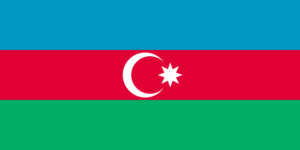History of Azerbaijan:
The Persian word “Land of Fire” is the source of the name Azerbaijan. The history of the nation is influenced by both the ancient Persians and the Turks from the 11th century.
The Arabs took control of what is now known as Azerbaijan in 642 AD. At that time, the populace was converted to Islam. The region prospered for the following few hundred years as an Arab province. The Mongols invaded after the Arab empire was overthrown. In the 13th and 14th centuries, the region was governed by the Mongol II-Khans, indigenous people for a while, and then the Persians.
With ports on the Caspian Sea and access to commercial routes connecting Asia, the Middle East, and Europe, Azerbaijan enjoyed an advantageous location. Major empires like the Ottoman Empire, Russia, and the Persian Empire fought over it as a result. Azerbaijan was divided in 1828 by the Persians and the Russians.
Azerbaijan was governed by Russia and Persia until World War I and the fall of the Russian Empire in 1917; it was prized for its oil reserves. Azerbaijan briefly enjoyed independence between 1918 and 1920, but after the Soviet Union invaded the country the same year, Azerbaijan joined the Soviet Union. It would stay there until it proclaimed independence on August 20, 1991.
Information about Azerbaijan:
| Capital | Baku (Baki, Baky) |
| Population | 10,422,540 (Source: 2023 worldometer) |
| Major Cities | Baku, Mingecevir, Sheki, Nakhchivan, Shamakhi, Aghdam, Shamkir, Khachmaz, Lankaran, |
| Borders | Armenia, Georgia, Iran, Russia |
| Gross Domestic Product (GDP) | $78,721,058,824 (2022 worldometer) |
| Currency | Azerbaijani manat (AZM) |
Flag of Azerbaijan:
Azerbaijan Economy Key Industries:
Azerbaijan Major Industries: petroleum and natural gas, petroleum products, oilfield equipment; steel, iron ore; cement; chemicals and petrochemicals; textiles
Azerbaijan Agricultural Products: cotton, grain, rice, grapes, fruit, vegetables, tea, tobacco; cattle, pigs, sheep, goats
Azerbaijan Natural Resources: petroleum, natural gas, iron ore, nonferrous metals, alumina
Azerbaijan Major Exports: oil and gas 90%, machinery, cotton, foodstuffs
Azerbaijan Major Imports: machinery and equipment, oil products, foodstuffs, metals, chemicals
The Geography of Azerbaijan:
Total Size of Azerbaijan: 86,600 km2 (source: wikipedia)
Geographical Low Point of Azerbaijan: Caspian Sea -28 m
Geographical High Point of Azerbaijan: Bazarduzu Dagi 4,485 m
Climate of Azerbaijan: dry, semiarid steppe
General Terrain of Azerbaijan: large, flat Kur-Araz Ovaligi (Kura-Araks Lowland) (much of it below sea level) with Great Caucasus Mountains to the north, Qarabag Yaylasi (Karabakh Upland) in west; Baku lies on Abseron Yasaqligi (Apsheron Peninsula) that juts into Caspian Sea
World Region or Continent of Azerbaijan: Asia
Geographical Coordinates: 40 30 N, 47 30 E
The People of Azerbaijan & Culture
Azerbaijan Government Type: republic
Azerbaijan Nationality: Azerbaijani(s), Azeri(s)
Azerbaijan National Holiday: Founding of the Democratic Republic of Azerbaijan, 28 May (1918)
Azerbaijan Independence: 30 August 1991 (from Soviet Union)
Azerbaijan National Symbol: flames of fire
Azerbaijan National Anthem or Song: Azerbaijan Marsi (March of Azerbaijan)
Azerbaijan Languages Spoken: Azerbaijani (Azeri) 89%, Russian 3%, Armenian 2%, other 6% (1995 est.)
Azerbaijan Religions: Muslim 93.4%, Russian Orthodox 2.5%, Armenian Orthodox 2.3%, other 1.8% (1995 est.
Interesting Facts about Azerbaijan:
Azerbaijan is the first democratic country in a strongly Islamic region. It is also the first Muslim country to have stage productions of operas and plays.
Azerbaijan is a country with a rich cultural heritage.
The meaning of the name Azer is “fire”. When people still inhabited Azerbaijan many centuries ago, they venerated and considered fire as a divinity. The letters “Az” and “er” together form the word “Azer.”
Azerbaijan is also referred to as “the Land of Fire.”
Azerbaijan briefly enjoyed independence from 1918 and 1920, but for the next 70 years it was once more a part of the Soviet Union.
The valley of the Kura River is Azerbaijan’s primary agricultural zone.
At 4466 meters (parent range: Greater Caucasus), Bazarduzu is the highest mountain in Azerbaijan.
Azerbaijan is the meeting point of two climate zones, one temperate and the other subtropical.
Hospitality is not just highly regarded but also a fundamental part of life in Azerbaijan. The host will pay for the guest’s meals and housing even if it means going over budget for their needs.
The national animal of Azerbaijan, the rare and beautiful Karabakh horse, is famous for its intellect, stamina, and agility.
The Nowruz festival, which is observed from March 20 to 24, is the country of Azerbaijan’s oldest national holiday. Iran, Tajikistan, Afghanistan, Kazakhstan, Albania, Turkmenistan, Uzbekistan, Georgia, and the Autonomous Region of Kurdistan are among the other 11 countries that observe it.
Without music, the lives of the inhabitants are incomplete. Traditional Azerbaijani music includes songs like Mugham.
Azerbaijan’s historical carpets are very well renowned and much sought for internationally. The majority of women weave these carpets, which demonstrate the country’s aesthetic sensitivity and ability to blend numerous symbols and designs with natural colors.
The Azerbaijani people use wood, silk, metal, and pottery to create intricate ornamental things. All across the world, museums display these works of art.
Baku is the location of the country’s carpet museum. The museum, which opened in 2014, has the appearance of a huge rug that has been compacted.
The skyscraper-filled metropolis of Baku welcomes tourists from all over the world.
The official language of Azerbaijan is Azerbaijani, which is spoken by the 20 million people who call the Islamic Republic of Iran home.
The biggest KFC restaurant is located in Baku, Azerbaijan. KFC has more than 18,875 franchise units throughout 118 nations.


